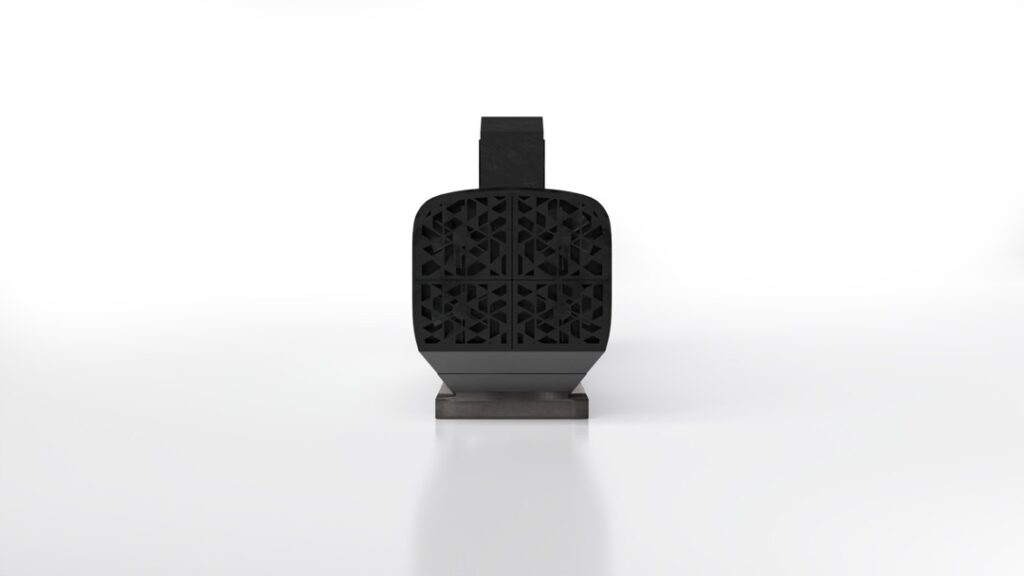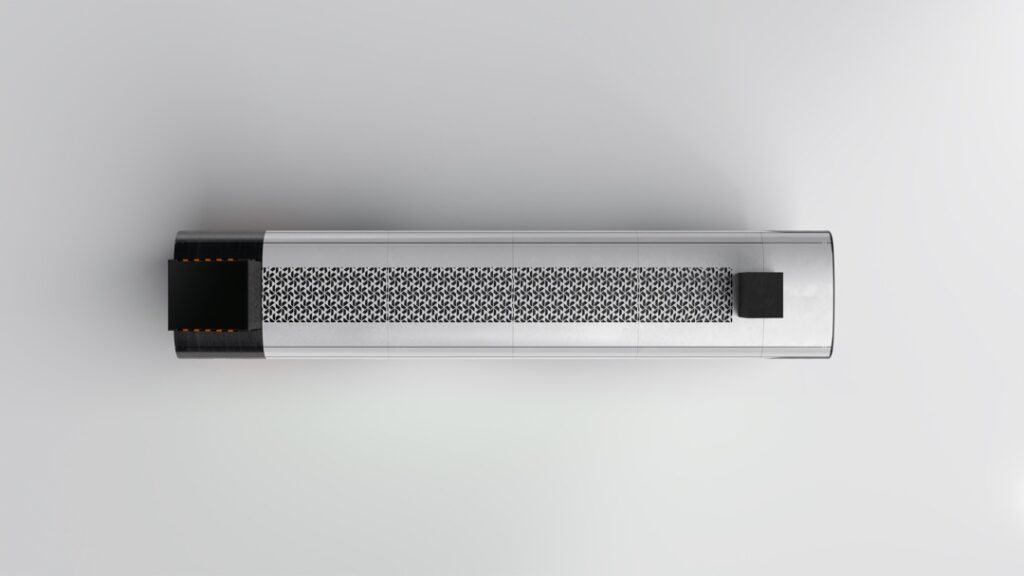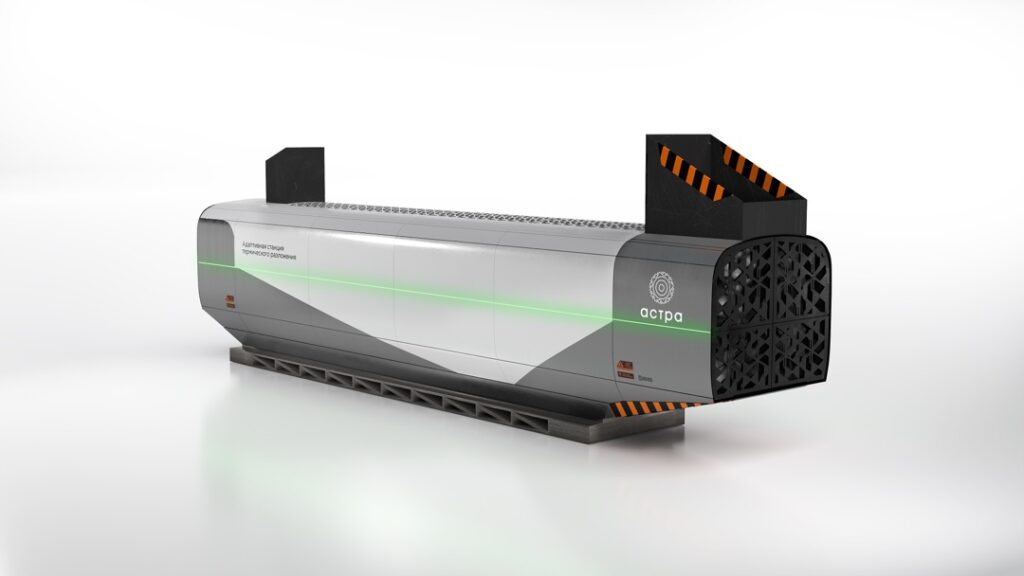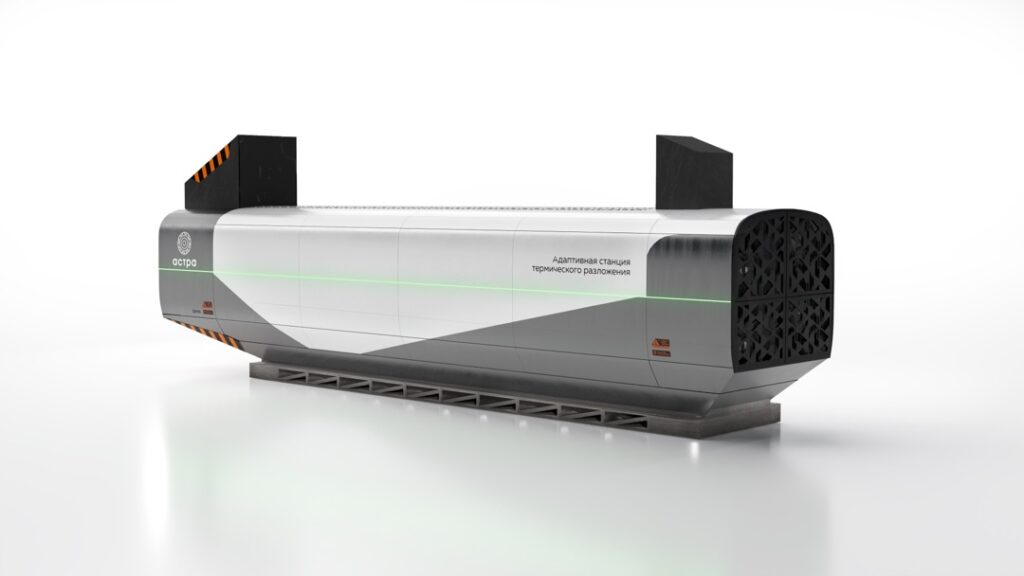What is Astra
Download detailed presentation
Astra (Adaptable Thermal Decomposition Station) is a unit that helps to save on waste disposal with no harm to the environment.
Production waste or garbage from the landfill is loaded into the unit.
As a result, environmentally friendly ash remains for secondary use, heat and electricity are generated.
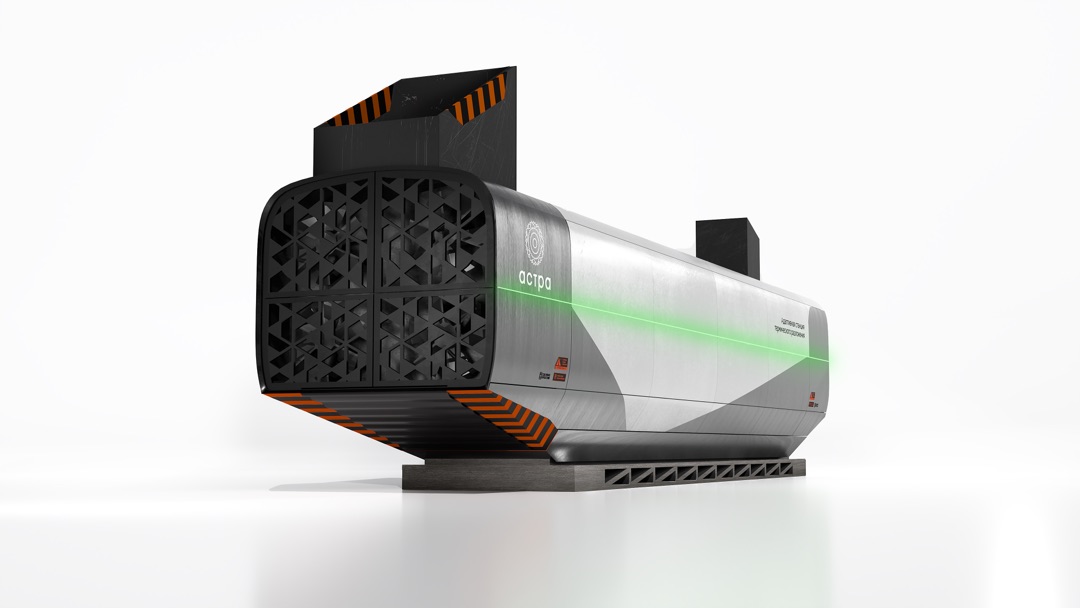
Astra has the following advantages:
- It is easily installed at the landfill or connected to the technological line of the enterprise — no need to take garbage out anywhere.
- It processes up to 5 tons of waste per hour without harmful air emissions.
- It supports any type of carbon-containing waste: organics, wood, rubber, plastic and much more.
- It reduces waste volume many times– up to 100 times.
- It generates minimum of 2 Gcal of heat and 700 kWh of electricity.
How Astra Helps to Save Money
Look at the example, how Astra turns the problem of waste disposal into a great way to save up to
- RUB 9.6 million per month if purchased
- 2.6 times if rented.
Example. To dispose one ton of waste at St. Petersburg or Leningrad Region landfills you will need:
- To collect waste and transfer to a landfill at the cost of RUB 1,500.
- To bury one ton of waste at a landfill at the cost of RUB 1,200.
Eventually, one ton of waste can be disposed of for an average of RUB 2,700 at St. Petersburg or Leningrad Region landfills. There are indirect costs, for example, garbage trucks damage road surfaces, landfill waste pollutes groundwater adjacent to the landfill area in a large radius around the landfill body, makes the soil under landfills unusable for decades, and emits unpleasant odors.
Saving with Astra.
The unit processes up to 5 tons of garbage per hour.
Using round-the-clock mode, it can process per month:
24 (hours) * 30 (days) * 5 (5 tons/hour) = 3,600 tons/month
Astra reduces the amount of garbage up to 100 times: the output is 36 tons of ash per month. The remaining 3,564 tons of garbage do not need to be taken out and buried — they are completely recycled locally.
Consequently, the savings on garbage disposal per month will be:
2700 (rate) * (3600-36) = RUB 9,622,800
In this case, the unit will pay off in less than a year.
| The cost of unit depends on the configuration — leave your contact details for calculation. |
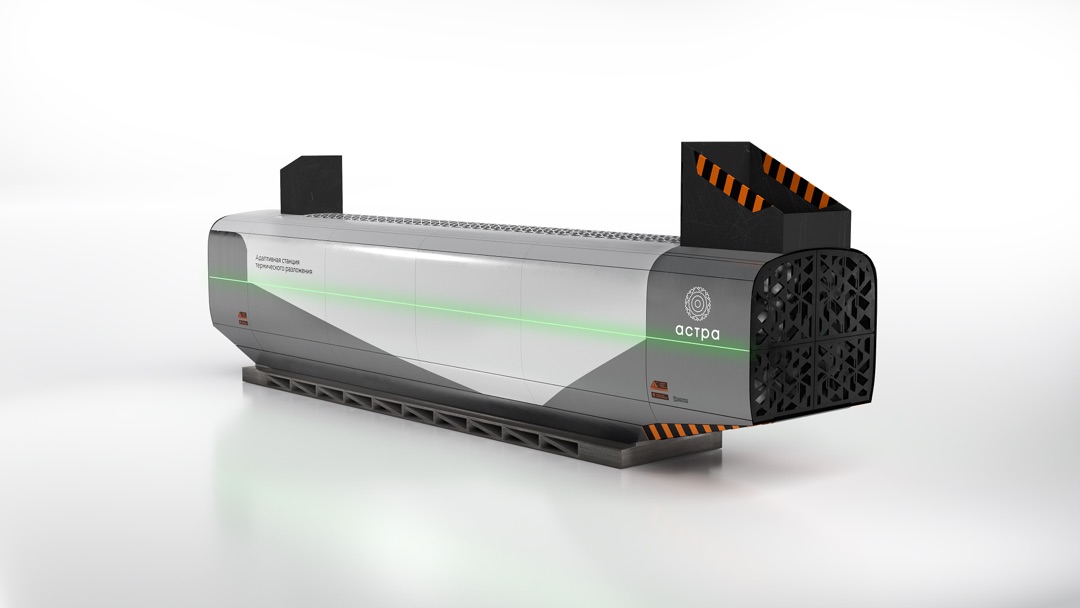
Instead of buying the unit, you can lease it signing a service contract.
You guarantee the loading of 5 tons of garbage per hour and pay for the recycling of waste at a rate: for example, 1000 rubles per ton *. (The rate depends on the region. The above specified rate is valid for St. Petersburg and Leningrad Region).
In a month, 3,600 tons of garbage are processed into 36 tons of ash. Even with standard landfill disposal, the cost of ash disposal will be:
(3600 * 1000) + (2700 * 36) = RUB 3,697,200
As a result, there will be a 2.6x reduction in disposal expenses.
In addition to reducing disposal costs, Astra allows you to additionally save:
- It produces 2 Gcal of heat energy, sufficient to heat an area of 42,000 m2 for a month.
- It generates 700 kWh of electricity – one household consumes an average of 220 kWh per month.
- It lessens environmental pollution – the process has no harmful air emissions and the produced ash can be used to produce fertilizers or construction materials.
- The roadbed is not damaged.
How Astra works
The unit works autonomously using some of the produced heat and electricity to maintain its operation, for example, for the rotation of electric motors, heating of garbage and functioning of the automation system.
Astra can be compared with a car.
The car is moving and its sensors, lights, and air conditioning system continue to function as long as there is fuel in its tank.
Similarly, the thermal decomposition unit works as long as you feed a particular amount of garbage into it.
However, there are some restrictions, as with a car:
1.Garbage must be served continuously — at least 2 tons per hour.
For the unit to function, it is necessary to recycle a minimum amount of waste. Like a car may stall if its fuel supply is cut off or drastically decreased.
2. Start-up process requires electricity and gas bottles. In order to go into operation, the unit needs 50 m3 of bottled domestic gas, as well as 12 kW of electricity. Like a car, you need a starter and a battery to get started. Bottles can be purchased from appropriate suppliers, and a diesel generator of the required capacity or the company’s network can be used for power supply.
3. The garbage must contain carbon so that the waste decomposes at high temperature into safe components.
Like a car with a gasoline engine, you need fuel with a certain octane number: AI-92, 95 or 98. Waste referring to hazard classes 3, 4 and 5 according to the Federal Classification Catalog of Waste (FCCO) will be suitable for the operation of the unit.
For example:
- organic waste from animal husbandry,
- poultry farming or sewage treatment plants;
- waste from pulp and paper or woodworking enterprises;
- sludge from mining and processing plants;
- medical and veterinary waste, etc.
The unit is adaptable; it does not require any adjustment for handling various waste kinds. For example, during the reclamation or liquidation of a landfill where unsorted garbage is stored.
4. The garbage must be crushed before loading. The waste must be crushed to avoid getting stuck in the unit. Any industrial shredder, shredding garbage to a fraction size of no more than 5 cm with a capacity of 5 tons per hour will be suitable for this purpose.
5. The waste needs to be sorted.
The installation works with carbon-containing waste. Therefore, before loading you have to sort out the garbage that cannot be recycled: concrete, sand, glass and metal.
How the recycling process works
Astra is a completely eco—friendly unit. It uses a patented (Patent of the Russian Federation, reg. No. 2459144) unique technology of thermal decomposition of garbage, which has no analogues in the world.
In the recycling process carbon-containing waste decomposes (rather than being incinerated) under high temperature into safe components:
Ash residue corresponds to the 4th–5th class of waste according to the Federal Classificatory Catalogue of Wastes (FCCW).
- carbon dioxide without dioxins, corresponding to SanPiN 2.1.3684-21 and GN 2.1.6.3492-17;
- chemically pure water.
This is how the waste recycling process looks like:

1. The loading hopper is designed for loading the feedstock. 2. The feeding screw is used to move the feedstock into the pre-chamber. 3. The pre-chamber is intended for preheating of the raw material. 4. The oxidation chamber is designed for high-temperature decomposition of the raw material. | 5. The evaporator is designed for vapor formation. 6. The water washing filter is designed for purification of flue gases. 7. The smokestack is designed for discharging flue gases. 8. The purifier is designed for filtration and discharge of finely-dispersed soot particles into the sludge hopper. 9. The sludge hopper is designed for collecting finely-dispersed particles. | 10. The condenser is designed for converting vapor into liquid. 11. The tank is designed for collecting condensate and its subsequent supply to the high-pressure zone of the turbine for generator rotation. 12. The turbine is designed for transferring torque to the generator. 13. The generator is designed for generating electricity. 14. The ash outlet is designed for removal of ash residue. 15. The ash collecting hopper is designed for collecting ash residue. |
Stage 1. The waste loaded into a hopper gets into a feeding screw where it is compressed and heated to 600 to 700 °C.
Stage 2. The heated raw material enters the oxidation chamber, where the main chemical reaction of partial oxidation takes place. Oxygen is supplied into the chamber with simultaneous heating to 1,500 °C and rarefaction. This is done in portions: so that the raw materials do not burn, releasing harmful substances, but decompose into components.
Stage 3. Carbon dioxide mixed with flue gases passes through a filter where it is purified from impurities and finely-dispersed particles. As a result, carbon dioxide is released without dangerous impurities that meets the standards for exhaust emissions into the environment (SanPiN 2.1.3684-21 and GN 2.1.6.3492-17).
Stage 4. Ash resulted from decomposition is moved by the screw and gathered into a separate container. The volume of the resulting ash residue is up to 100 times less than the initial volume of garbage.
Stage 5. The hot water from the partial oxidation process enters the evaporator and is converted into vapour, which is then used to generate heat and electricity.
Stage 6. The vapor is split into two streams
One stream is condensed and pumped through a heat exchanger, thus producing 2 Gcal of heat per hour.
Another stream is treated and fed to a turbine, which drives a generator, with a minimum electricity output of 700 kWh.
Stage 7. The process repeats: the exhaust vapor flows back into the evaporator.
When compared with other existing recycling methods, our technology surpasses all known ones.
Landfilling – the most widespread approach to waste management is also the least rational.
it requires large territories for garbage storage hazardous substances penetrate into the soil and pollute groundwater.
Recycling — a method that turns waste into goods or houseware through reprocessing. The issue is that up to 50% of waste still remain unprocessed and needs to be disposed of in the same landfills.
Incineration. This method involves using open-burning furnaces, or incinerators. They solve the problem of landfills, but dangerous dioxins are released into the atmosphere during combustion. This pollutes the environment and is banned by many countries.
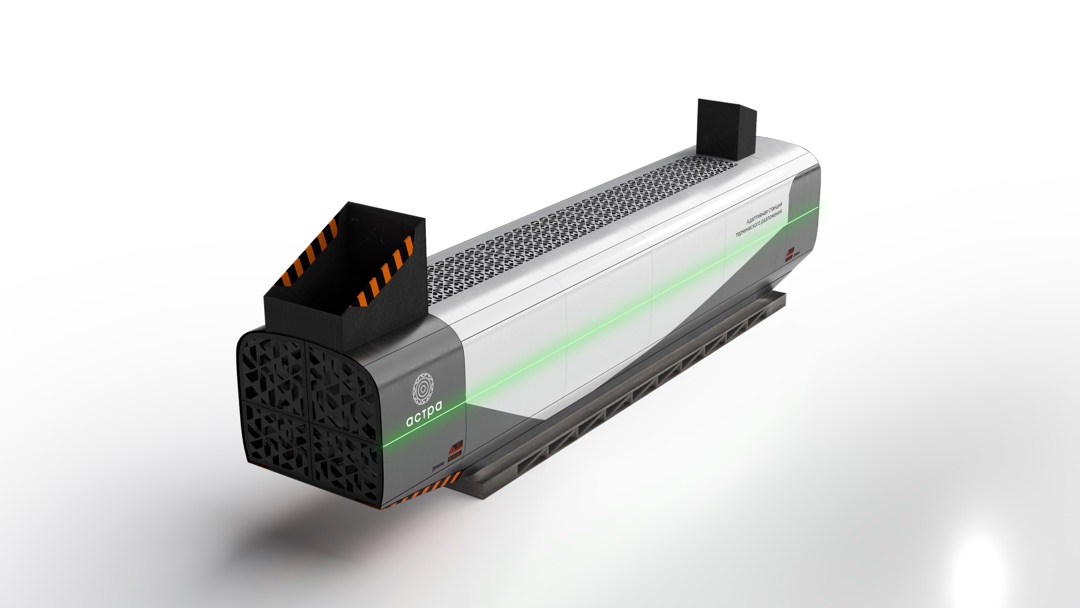
Technical characteristics of the unit
| Nominal volume of loaded raw materials | 5 tons/hour |
| Minimum volume of loaded raw materials | 2 tons/hour |
| Electricity consumption | 5–15 kW |
| The volume of produced waste (4- and 5-class ashes according to FCCW) | In proportion to the volume of processed raw materials is from 1:50 to 1:100 |
| Service life | 10 years |
| Duty cycle | Continuous |
| Number of start/stop cycles during the design service life, maximum | Vertical (В): 50 Horizontal (У): 40 |
| Operating temperature conditions | –50 to +50 °С |
| Generated heat energy | > 2 Gcal |
| Electricity generated by processing 5 tons of raw material per hour is | > 700 kWh |
| Personnel required | 2 operators per shift |
| After-sales service | once in 340 days with complete shutdown and start-up |
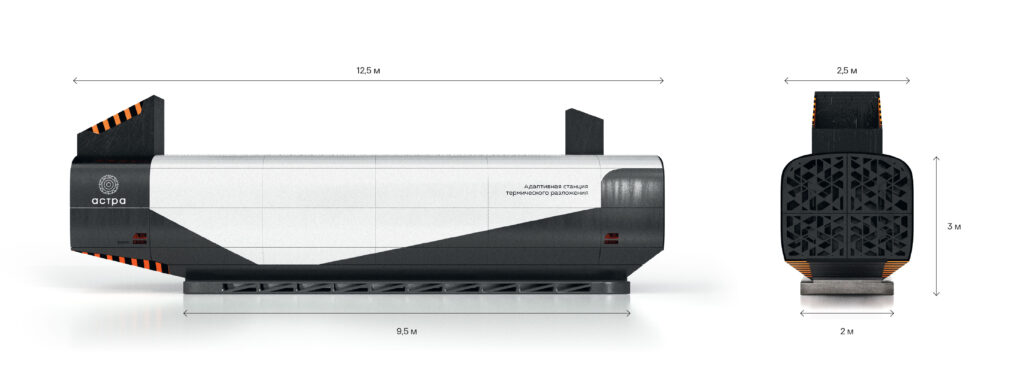
Curb weight without feedstock loaded is 12 tons
If you want to know more – please, download our detailed presentation
Leave your contacts — we will contact you, answer any questions and help you make a decision.


